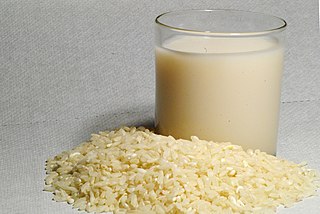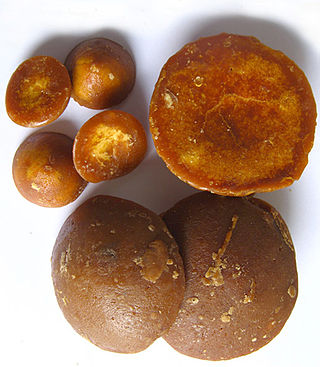Related Research Articles

A carbohydrate is a biomolecule consisting of carbon (C), hydrogen (H) and oxygen (O) atoms, usually with a hydrogen–oxygen atom ratio of 2:1 and thus with the empirical formula Cm(H2O)n, which does not mean the H has covalent bonds with O. However, not all carbohydrates conform to this precise stoichiometric definition, nor are all chemicals that do conform to this definition automatically classified as carbohydrates.
Intensive insulin therapy or flexible insulin therapy is a therapeutic regimen for diabetes mellitus treatment. This newer approach contrasts with conventional insulin therapy. Rather than minimize the number of insulin injections per day, the intensive approach favors flexible meal times with variable carbohydrate as well as flexible physical activities. The trade-off is the increase from 2 or 3 injections per day to 4 or more injections per day, which was considered "intensive" relative to the older approach. In North America in 2004, many endocrinologists prefer the term "flexible insulin therapy" (FIT) to "intensive therapy" and use it to refer to any method of replacing insulin that attempts to mimic the pattern of small continuous basal insulin secretion of a working pancreas combined with larger insulin secretions at mealtimes. The semantic distinction reflects changing treatment.

Lactose, or milk sugar, is a disaccharide sugar composed of galactose and glucose subunits and has the molecular formula C12H22O11. Lactose makes up around 2–8% of milk (by mass). The name comes from lact (gen. lactis), the Latin word for milk, plus the suffix -ose used to name sugars. The compound is a white, water-soluble, non-hygroscopic solid with a mildly sweet taste. It is used in the food industry.

Fructose, or fruit sugar, is a ketonic simple sugar found in many plants, where it is often bonded to glucose to form the disaccharide sucrose. It is one of the three dietary monosaccharides, along with glucose and galactose, that are absorbed by the gut directly into the blood of the portal vein during digestion. The liver then converts both fructose and galactose into glucose, so that dissolved glucose, known as blood sugar, is the only monosaccharide present in circulating blood.

Lactose intolerance is caused by a lessened ability or a complete inability to digest lactose, a sugar found in dairy products. Humans vary in the amount of lactose they can tolerate before symptoms develop. Symptoms may include abdominal pain, bloating, diarrhea, flatulence, and nausea. These symptoms typically start thirty minutes to two hours after eating or drinking something containing lactose, with the severity typically depending on the amount consumed. Lactose intolerance does not cause damage to the gastrointestinal tract.

Yogurt is a food produced by bacterial fermentation of milk. Fermentation of sugars in the milk by these bacteria produces lactic acid, which acts on milk protein to give yogurt its texture and characteristic tart flavor. Cow's milk is most commonly used to make yogurt. Milk from water buffalo, goats, ewes, mares, camels, and yaks is also used to produce yogurt. The milk used may be homogenized or not. It may be pasteurized or raw. Each type of milk produces substantially different results.

Xylitol is a chemical compound with the formula C
5H
12O
5, or HO(CH2)(CHOH)3(CH2)OH; specifically, one particular stereoisomer with that structural formula. It is a colorless or white crystalline solid that is freely soluble in water. It can be classified as a polyalcohol and a sugar alcohol, specifically an alditol. The name derives from Ancient Greek: ξύλον, xyl[on] 'wood', with the suffix -itol used to denote sugar alcohols.

The glycemic (glycaemic) index is a number from 0 to 100 assigned to a food, with pure glucose arbitrarily given the value of 100, which represents the relative rise in the blood glucose level two hours after consuming that food. The GI of a specific food depends primarily on the quantity and type of carbohydrate it contains, but is also affected by the amount of entrapment of the carbohydrate molecules within the food, the fat and protein content of the food, the amount of organic acids in the food, and whether it is cooked and, if so, how it is cooked. GI tables, which list many types of foods and their GIs, are available. A food is considered to have a low GI if it is 55 or less; high GI if 70 or more; and mid-range GI if 56 to 69.

Rice milk is a plant milk made from rice. Commercial rice milk is typically manufactured using brown rice and brown rice syrup, and may be sweetened using sugar or sugar substitutes, and flavored by common ingredients, such as vanilla. It is commonly fortified with protein and micronutrients, such as vitamin B12, calcium, iron, or vitamin D.
The glycemic load (GL) of food is a number that estimates how much the food will raise a person's blood glucose level after it is eaten. One unit of glycemic load approximates the effect of eating one gram of glucose. Glycemic load accounts for how much carbohydrate is in the food and how much each gram of carbohydrate in the food raises blood glucose levels. Glycemic load is based on the glycemic index (GI), and is calculated by multiplying the weight of available carbohydrate in the food (in grams) by the food's glycemic index, and then dividing by 100.

Tagatose is a hexose monosaccharide. It is found in small quantities in a variety of foods, and has attracted attention as an alternative sweetener. It is often found in dairy products, because it is formed when milk is heated. It is similar in texture and appearance to sucrose :215 and is 92% as sweet,:198 but with only 38% of the calories.:209 Tagatose is generally recognized as safe by the Food and Agriculture Organization and the World Health Organization, and has been since 2001. Since it is metabolized differently from sucrose, tagatose has a minimal effect on blood glucose and insulin levels. Tagatose is also approved as a tooth-friendly ingredient for dental products. Consumption of more than about 30 grams of tagatose in a dose may cause gastric disturbance in some people, as it is mostly processed in the large intestine, similar to soluble fiber.:214

Isomaltulose is a disaccharide carbohydrate composed of glucose and fructose. It is naturally present in honey and sugarcane extracts and is also produced industrially from table sugar (sucrose) and used as a sugar alternative.
The insulin index of food represents how much it elevates the concentration of insulin in the blood during the two-hour period after the food is ingested. The index is similar to the glycemic index (GI) and glycemic load (GL), but rather than relying on blood glucose levels, the Insulin Index is based upon blood insulin levels. The Insulin Index represents a comparison of food portions with equal overall caloric content, while GI represents a comparison of portions with equal digestible carbohydrate content and the GL represents portions of a typical serving size for various foods. The Insulin Index can be more useful than either the glycemic index or the glycemic load because certain foods cause an insulin response despite there being no carbohydrates present, and some foods cause a disproportionate insulin response relative to their carbohydrate load.
A diabetic diet is a diet that is used by people with diabetes mellitus or high blood sugar to minimize symptoms and dangerous complications of long-term elevations in blood sugar.
MDPI is a publisher of open-access scientific journals. It publishes over 390 peer-reviewed, open access journals. MDPI is among the largest publishers in the world in terms of journal article output, and is the largest publisher of open access articles.

The Western pattern diet is a modern dietary pattern that is generally characterized by high intakes of pre-packaged foods, refined grains, red meat, processed meat, high-sugar drinks, candy and sweets, fried foods, industrially produced animal products, butter and other high-fat dairy products, eggs, potatoes, corn, and low intakes of fruits, vegetables, whole grains, pasture-raised animal products, fish, nuts, and seeds.

Yacón syrup is a sweetening agent extracted from the tuberous roots of the yacón plant indigenous to the Andes mountains.

Coconut sugar is a palm sugar produced from the sap of the flower bud stem of the coconut palm.
The Australian paradox is an observation of diverging trends in sugar consumption and obesity rates in Australia. The term was first used in a 2011 study published in Nutrients by Professor Jennie Brand-Miller, in which she and co-author Dr. Alan Barclay reported that, in Australia, "a substantial decline in refined sugars intake occurred over the same timeframe that obesity has increased."

Pure, White and Deadly is a 1972 book by John Yudkin, a British nutritionist and former Chair of Nutrition at Queen Elizabeth College, London. Published in New York, it was the first publication by a scientist to anticipate the adverse health effects, especially in relation to obesity and heart disease, of the public's increased sugar consumption. At the time of publication, Yudkin sat on the advisory panel of the British Department of Health's Committee on the Medical Aspects of Food and Nutrition Policy (COMA). He stated his intention in writing the book in the last paragraph of the first chapter: "I hope that when you have read this book I shall have convinced you that sugar is really dangerous."
References
- 1 2 "Taking the sweet with the sour". The Sydney Morning Herald. 19 April 2003. Retrieved 18 April 2024.
- 1 2 Brand, Janette C.; Miller, John J.; Vorbach, E. Athol; Edwards, Ronald A. (November 1977). "A TRIAL OF LACTOSE HYDROLYSED MILK IN AUSTRALIAN ABORIGINAL CHILDREN". Medical Journal of Australia. 2 (SP4): 10–13. doi:10.5694/j.1326-5377.1977.tb107779.x. ISSN 0025-729X.
- ↑ Miller, John James (1989). Relationship of infantile colic to breath hydrogen and lactose malabsorption (Thesis thesis). UNSW Sydney.
- ↑ Gardiner, Andrew (26 March 2024). "Big Sugar, Big Pharma: Sydney University compromised by academic research breach". Michael West. Retrieved 18 April 2024.
- ↑ Miller, John James (1989); pp. iii-v in "Acknowledgements" in University of NSW PhD Dissertation "Relationship of infantile colic to breath hydrogen and lactose malabsorption"; https://unsworks.unsw.edu.au/entities/publication/7fa38e73-2271-43dd-955e-8c253b0262a1/full
- 1 2 3 "Professor Jennie Brand-Miller | Australian Academy of Science". www.science.org.au. Retrieved 16 June 2018.
- ↑ Gardner, Tom (2 March 2014), Sweet research goes sour (PDF), HoniSoit
- ↑ Pascoe, Michael (7 March 2012), "Economist v nutritionists: big sugar and low-GI brigade lose", Sydney Morning Herald, Fairfax
- ↑ Sugar Consumption in Australia - A Statistical Update (PDF), GreenPool Commodities, 4 October 2012, archived from the original (PDF) on 23 November 2014
- ↑ Levy, Gina S.; Shrapnel, William S. (2014). "Quenching Australia's thirst: A trend analysis of water-based beverage sales from 1997 to 2011". Nutrition & Dietetics. 71 (3): 193–200. doi:10.1111/1747-0080.12108. ISSN 1747-0080.
- ↑ "Australian Health Survey: Nutrition First Results - Foods and Nutrients". www.abs.gov.au. Australian Bureau of Statistics. 9 May 2014. Retrieved 26 November 2019.
- ↑ Barclay, Alan W.; Brand-Miller, Jennie (2014). "Barclay, A.W. and Brand-Miller, J. The Australian Paradox: A Substantial Decline in Sugars Intake over the Same Timeframe that Overweight and Obesity Have Increased. Nutrients 2011, 3, 491-504". Nutrients. 6 (2): 663–664. doi: 10.3390/nu6020663 . PMC 3942725 .
- ↑ "Conclusions from OASPA Membership Committee Investigation into MDPI". OASPA. 11 April 2014. Retrieved 26 November 2019.
- ↑ "News and events".
- ↑ Morgan, Branwen (13 June 2011), "Nutritionist recognised for pioneering work", ABC News in Science, ABC, retrieved 16 December 2017
- ↑ "Queen's Birthday 2022 Honours - the full list". Sydney Morning Herald. Nine Entertainment Co. 12 June 2022. Retrieved 12 June 2022.